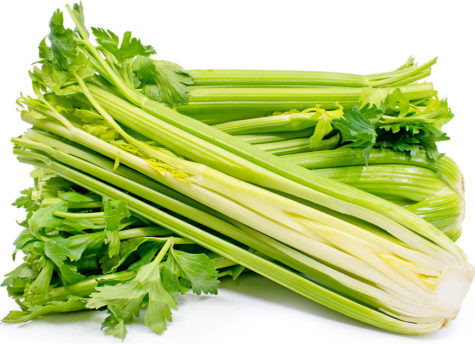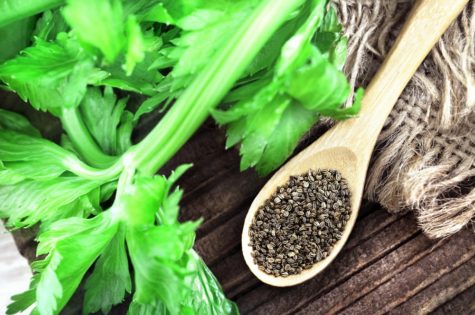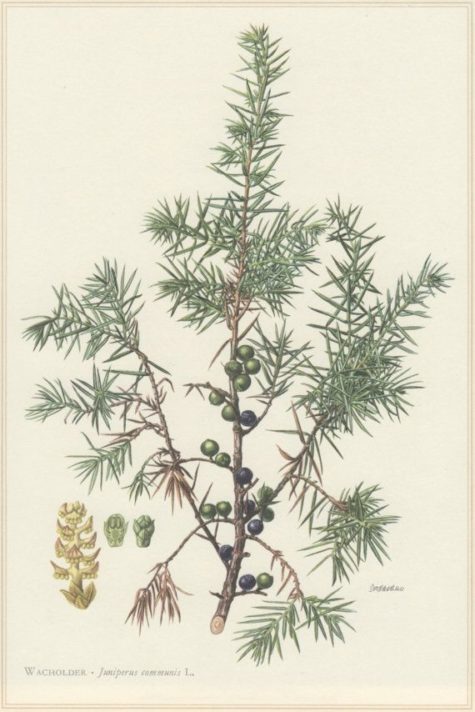Antirheumatic
Celery
- Scientific Name: Apium graveolens var. dulce
- Plant Family: Umbelliferae
- Parts Used: Leaves, Stalks, Seeds, Roots
- Actions: Digestive, Stimulant, Diuretic, Anti-rheumatic, Carminative, Sedative, Aromatic
This is the cultivated celery, introduced into Britain in the late 17th century from Italy, replacing as a potherb the acrid little wild celery, known as “smallage,” that grows in salt marshes and river estuaries in Britain and Europe.
Some people use celery on the skin to repel mosquitoes. Some people also take celery by mouth for conditions such as menstrual cramps, prediabetes. Unblanched celery is rich in vitamins and mineral salts. It is a digestive and stimulant with a reputation for lowering blood pressure.
Celery seeds find their main use in the treatment of rheumatism, arthritis, and gout. They are especially useful in rheumatoid arthritis where there is an associated mental depression. Their diuretic action is obviously involved in rheumatic conditions, but they are also used as a urinary antiseptic, largely because of the volatile oil apiol.
Appearance
The leaves are smooth, shining, yellow-green and feathery, and the fleshy ridged stem is a bright green unless blanched pale. It is a biennial, umbels of white flowers appearing in late summer during the second year, followed by dark, ridged seeds.
Habitat and Cultivation
Celery thrives in cool, mild climates and requires high levels of moisture. Growing to a height of 15-24 inches, celery has long, fibrous petioles formed by conically arranged stalks joined at the base that surround the heart of the celery plant. The stalks each produce three to five bright green, pinnate leaves at the tip of the stalk.
Celery’s small white or yellow flowers appear in umbels from January to August during the plant’s second year of growth. The celery fruits, or schizocarps, consist of two united carpels (mericarps), each containing a brown, ridged, ovoid-shaped, very small seed, approximately 1.3 mm in length. These fruits, known in commerce as “celery seed,” have a floral odor and slightly pungent taste, and typically ripen in August and September.
Celery is cultivated worldwide. Celery’s Latin binomial, Apium graveolens, translates to “strongly smelling” and alludes to celery’s aromatic compounds.
Cultivated celery has been bred for its elongated, thick, fleshy, ribbed, milder-tasting stalks, while wild celery is grown for its bitter leaves. By the early 19th century, four varieties of celery were cultivated in the United States, where the plant gained popularity as a salad vegetable.
Three varieties of celery are the most commonly cultivated:
- Chinese celery (var. secalinum), which is used sparingly as a condiment due to its strong, bitter taste.
- Stalk celery (var. dulce), which is eaten raw in salads or cooked.
- Celeriac or “turnip-rooted celery” (var. rapaceum), which is grown for its enlarged root. Celeriac is popular in European cuisine and its seeds also are used for making commercial celery salt.
Medicinal Uses
Cooling thermal nature; sweet and bitter flavor, Celery benefits the stomach and spleen-pancreas and calms an aggravated liver. It improves digestion, dries damp excesses, purifies the blood, reduces wind conditions such as vertigo and nervousness, and promotes sweating.
Also used for heat excesses such as eye inflammations, burning urine, blood in the urine, acne, and canker sores. It will cool internal heat in the liver and stomach, which often contributes to headaches and excessive appetite, among other maladies.
For appetite control, raw celery can be eaten between and during meals. To slow down and encourage more thorough chewing of food, eat celery with a meal.
Celery is one of the few vegetables that combines well with fruit, as it has an ability to dry damp conditions, including those associated with eating fruit and concentrated sweeteners.
Celery juice combined with a little lemon juice is a remedy for the common cold when fever is more prominent than chills. The combination is helpful in headaches caused by high blood pressure or by heat conditions (red face, head feels hot, red tongue, and/or irritability).
Celery juice alone or in combination with lemon is useful for diabetes and helps clear the acidosis commonly caused by diabetes. For this purpose, drink 2 to 4 cups of the juice daily.
Very high in silicon, celery helps renew joints, bones, arteries, and all connective tissues. Because of these effects and the capacity of celery to clear digestive fermentation (dampness) and acidic blood that frequently accompany tissue inflammations, it is useful in the treatment of rheumatism, arthritis, gout, and nerve inflammations.
Both the stalks and roots are used in the East and West to treat high blood pressure and are a safe remedy for high blood pressure during pregnancy.
It is thought that the chemicals in celery can have many effects on the human body, including lowering blood pressure and blood sugar and causing sleepiness, but there is limited research to support these proposed effects. Chemicals in celery seem to reduce the ability of bacteria to cause urinary tract infections (UTIs).
Celery seeds, leaves, stem, and root are used in a variety of traditional medicine systems, including the Unani tradition of ancient Persia and Arabia, Indian Ayurveda, and Chinese herbal medicine. As an herbal preparation, celery seeds were consumed fresh or as a water decoction, or the seed powder or extracts were used. Continue reading
Juniper
- Scientific Name: Juniperus, communis
- Plant Family: Pinaceae
- Parts Used: Berries, leaves and twigs, bark
- Constituents: Rich in essential oil which contains monoterpenes and sesquiterpenes, invert sugar, flavone glyosides, resin, tannin, organic acids
- Actions: Diuretic, Stimulant, Carminative, Emmenagogue, Antimicrobial, Anti-rheumatic, Abortifacient
- How does it work? Juniper berries contain chemicals that might decrease swelling. It might also be effective in fighting bacteria and viruses. Juniper might also increase the need to urinate.
Varieties:
There are over sixty Juniper species, but the one which yields edible fruits in Britain is Juniperus comunis. In the Americas, Eastern Red Cedar, Juniperus virginiana, can be used in much the same way. A detailed account of the herbal properties of Eastern Red Cedar can be found here.
Among the varied forms, there are dense, columnar trees; medium sized, rounded shrubs; irregular bush forms; and creeping prostrate types. Irish and Swedish junipers are tall, narrow, and quick growing; the Greek and Chinese are very compact, slow growing. Pfitzers are irregular, massive types. California Juniper may reach heights of 40 feet, and shore Juniper and japonica are spreading ground covers.
Notes and Cautions:
One useful guide to the identification of Juniper is the apple-like fragrance that the needle-shaped leaves give off when crushed.
Women who are pregnant, wish to become pregnant, or who are nursing a child should not eat Juniper fruits. Due to their action on the kidneys, Juniper berries should be avoided by persons with kidney disease.
Don’t confuse Juniper berry oil with cade oil, which is distilled from Juniper wood (Juniperus oxycedrus).
The Basics:
A strong aromatic scent emanates from all parts of the shrub. Berries taste slightly bitter-sweet, fragrant, and spicy and are generally used to make a tea that is good for flatulence and indigestion, to promote the flow of urine.
Juniper branches can be used as a fumigant and were commonly burned in public places in times of plague and pestilence. This was still the practice in French hospitals a century ago during the smallpox epidemic of 1870.
Juniper berries make an excellent antiseptic in conditions such as cystitis. The essential oil present is quite stimulating to the kidney nephrons and so this herb should be avoided in kidney disease. The bitter action aids digestion and eases flatulent colic. It is used in rheumatism and arthritis. Externally it eases pain in the joints or muscles.
Some people take Juniper by mouth for problems with digestion, urinary tract infections (UTIs), and kidney and bladder stones along with many other conditions. Some people apply Juniper directly to the skin for wounds and pain in joints and muscles.
In foods, Juniper berry is often used as a condiment. The extract, oil, and berry are used as flavoring ingredients in foods and beverages. In manufacturing, Juniper extract and oil are used as fragrances in soaps and cosmetics.
Rennie Luttrull: queen-annes-lace-seeds
Rosanna: Spignel aka Bald Money
Annamarie Squatrito: Fumitory
EILEEN Klinghagen: Pumpkin
Mahmudul Hasan: Celery







